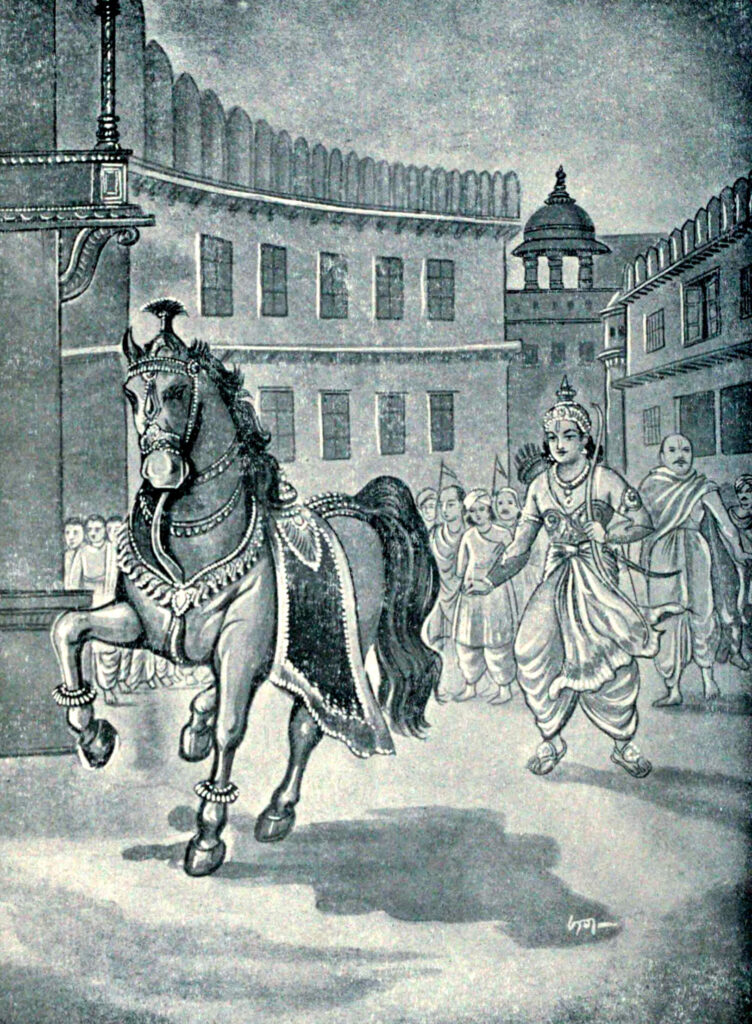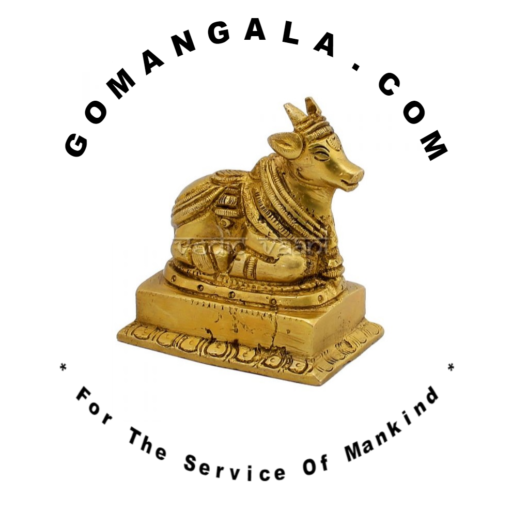Rama was the ideal royal administrator of any time on this earth. One day, he expressed to conduct the Ashwamedha Yajna with his brothers, Lakshmana and Bharata, as per the decisions of the council of his advisors. Then, the brothers desired to know the effectiveness of the Ashwamedha yajna and fruitfulness after its completion. Many Rishis had visited Rama and he had acquired great experiences. In order to convince them, a live incident had been narrated by Rama as follows:

Prathishtanagar might be the present Patna in Bihar. King Budha was ruling there. To the southern side, the country Bahlika was ruled by Kardama and later he crowned his son Ila. Prince Ila had an illness of automatically changing as a queen, and again had become normal after a year. Later, again during his fifteenth year, he changed as lady. Like, in alternate years he would suffer from Transgender transformation problem.
One day, Kardama had arranged a royal meeting of expert physicians at his palace of Bahlika country. He invited great physicians like Atri, Bhargavarama Chyavana, Durvasa and Anusuya. They discussed regarding the illness of Ila about automatically changing as a lady in his alternate years of age. Kardama had invited the king of his neighborhood, Budha from Prathishtanagar also. They had finalized the remedies and informed Kardama to implement them one by one strategically.
Then, Ila was a lady, aged nineteen and Budha had crossed twenty one years. Hence they would marry if they would agree for the proposal. They agreed and married. Then the two countries also extended their cooperation and Budha remained in the Palace of Ila for that full one year. A male child had been blessed by God Shiva to them and it was named as Pururava. After a few days, IIa became normal and Budha went back to Prathishtanagar. Next, the second and wisest suggestion was to conduct an Ashwamedha yajna if Ila becomes a lady again, to please God Shiva and get the remedy from him. Then, immediately Ila became a lady and they started one Ashwamedha yajna to please God Shiva without an actual animal, the horse, but with the help of learned scholars.
नान्यं पश्यामि भैषज्यमंतरा वृषभध्वजं । नाश्वमेधात्परो यज्ञः प्रियश्चैव महात्मनः ॥
Meaning: The lone physician able to provide a remedy against this disease would be, God Shiva, he only, and there is no other yajnas which could more please him, other than the Ashwamedha yajna.
Both Budha and Ila worshipped God Shiva and conducted the yajna but Ashwamedha was completed without an animal, i.e., a live horse. The horse intelligentsia methods of rituals were referred as Ashwamedha yajna in Sanskrit. It had been described under the chapters of Kalpasutra, a code book for conducting rituals. Thus the yajna was carefully performed by Ila and Budha.
God Shiva was pleased and on his show in physical form, blessed Ila to be always a gentleman and a good king. When Pururava had completed his education, Kardama had gone for higher order of penance and Budha returned to Prathishtanagar. Hence Ila alone ruled as a good king. He was thinking to conduct the marriage of his son Pururava and sent his servants in search of a suitable bride matching for him. But then, Budha expired, so he had gone to Prathishtanagar to take charge as a king of that country. Prior to leaving his country, he had crowned Pururava as the king of Bahlika country. Hence after the Ashwamedha, by the blessings of God Shiva, they became happy. Prathishtanagar could be the present Patna city and Bhanga Ila Rajya later called as Bangla, folks modified and named in colloquial word of Bahlika.
Bharata and Lakshmana prepared for the Ashwamedha yajna in Ayodhya. A special site was selected and made the earth level, with tents and required halls erected. It was nearer to the hermit of Valmiki and the place was called as Naimisharanya.
Freedom to be ensured to all
Rama was eager to ensure freedom throughout the universe to all. Hence the horse was left free; it was a symbol of freedom. It was black in color. Since the horse could not move to Lanka, Rama had specially and personally invited Vibhishana with his demon folks to Ayodhya for the ceremony. There were no restrictions of age or any differentiations but all should feel happy within the sphere of Dharma.
King Rama could come to know about the degree of freedom through the free movement of the horse. It was tied at the Ashram of Valmiki. When it was released, Valmiki had not disclosed the identity of his disciples as Lava and Kusha and no news of Sita were flashed to him. However arrangements had been specially done for Valmiki and for his disciple by erecting special tents near to his Ashram by the servants of Rama. In special carts, food supplies had been arranged and were parked near the gate till the conclusion ceremony of the Ashwamedha yajna at Naimisharanya. Valmiki Rishi had sent his two disciples with instructions to recite the Ramayana verses with background tunes played by the stringed Tambura provided by him and as taught by him.
Valmiki Rishi had specially told them, not to accept any gold, silver or gem stones, if offered as compensation, and would politely inform them; in the deep forests such items were not required, since they were under the tutorship of Valmiki Rishi. Rama did not know about the disciples till the appearance of Sita on the seventh day and had declared them as his children Lava and Kusha, after the recitation of Ramayana.
Recognition to all and easy to approach by anybody
King Suratha of Nagaloka had tied the horse. The serpents could not see Rama even once in their life. The stories of Angada make clear how Rama allowed them and invited them to the Ashwamedha. It shows the greatness of Rama through the yajna. Hence, the horse moved freely.
Rama had invited his friend Sugriva and all his people to the yajna place. Monkeys never eat meat. All monkeys were vegetarians. Hence there was only vegetarian food in Rama’s Ashwamedha. Food for all was also ensured.
Some Rishis liked to sit alone. Hence arrangements had been done for their solitude sitting also. Lakshmana had lived in the forests with Rama for many years and was experienced in constructing the huts for Rishis. They would be mute spectators of the gorgeous events of the Ashwamedha yajna of Rama.
Transportation of essentials without stagnations
In the Valmiki Ramayana, the arrangements of transportation of essentials was highly stressed and arranged to avoid stagnations. There were no compulsions but every movement was dedicated from the heart of the people with reverence. There was no beggars’ sound. The desire of all had been properly addressed for fulfillment.
The main benefit for Ayodhya was the coming of children Lava and Kusha to the palace after reciting Ramayana:
दिवसे विंश्तिः सर्गाः गेया मधुरया गिरा । प्रमाणैर्बहुभिस्तत्र यथोद्दिष्टं मया पुरा ॥
Meaning: On daily basis, on each day, the verses of twenty sargas, to be recited, then it would require, thirty two days to complete the six hundred and forty sargas. It was desired by Valmiki Maharshi, to recite with a background tune in the above order and he told there would be twenty four thousand verses in total.
One year was required for the preparations of the Ashwamedha yajna.
There are seven Kandas in Ramayana. In the solar calendar month of Karkataka, during the thirty two days, people used to read Ramayana. This system is continued in current days also. Hence it might be completed by Lava and Kusha within one month. Again, for one week, after one month, a repetition of the entire verses insisted by Rama when the subject had got his attention and aroused the suspicion about the children. Accordingly, they recited one Kanda each day. But, Rama ordered on the sixth day to accompany their mother and teacher on the following day, the seventh day. Centuries after, many verses have gone lost and many verses inserted to preserve it in order by able scholars, but the master theme is unchanged, and would continue forever.
Ashwamedha yajna had a chapter in Kalpasutra explaining the methods to be followed and the rituals to be performed. Various purposes would be achieved by performing such yajnas in olden days. Some of the commentaries were available regarding the rituals and yajna in various languages but not audited with reference to the code of conduct of the Kalpasutra which were in Sanskrit language only.
After Lava and Kusha came to Ayodhya, Rama had conducted many yajnas.
दर्श वर्श सहस्राणि वाजिमेधानथाकरोत् । वाजपेयान् दशगुणांस्तथा बहुसुवर्णकान् ॥
Meaning: Rama had performed many Ashwamedha yajnas later. He had done Vajapeya with ten times glory, the yajnas, incurring many gold and assets. He always ensured the freedom in the country and provided happiness to all.
There was no expansion idea in Ramayana. Dandakaranya was still under ruling of Vibhishana. Sugriva was enjoying freedom with his people in Kishkindha. There was no problem in taxes for treasury, and people could offer themselves one sixth of their earnings to Rama and he used to spend them for the people, which were witnessed by Hanuman as an angel in his palace.
It is humbly prayed for the blessings of God Rama upon us.
Next post, being Civil Engineering in Ramayana may not be missed. Apprenticeship and Internship would be presented separately in another article.
Readers may provide feedback and share this story with friends and family.

Leave a Reply